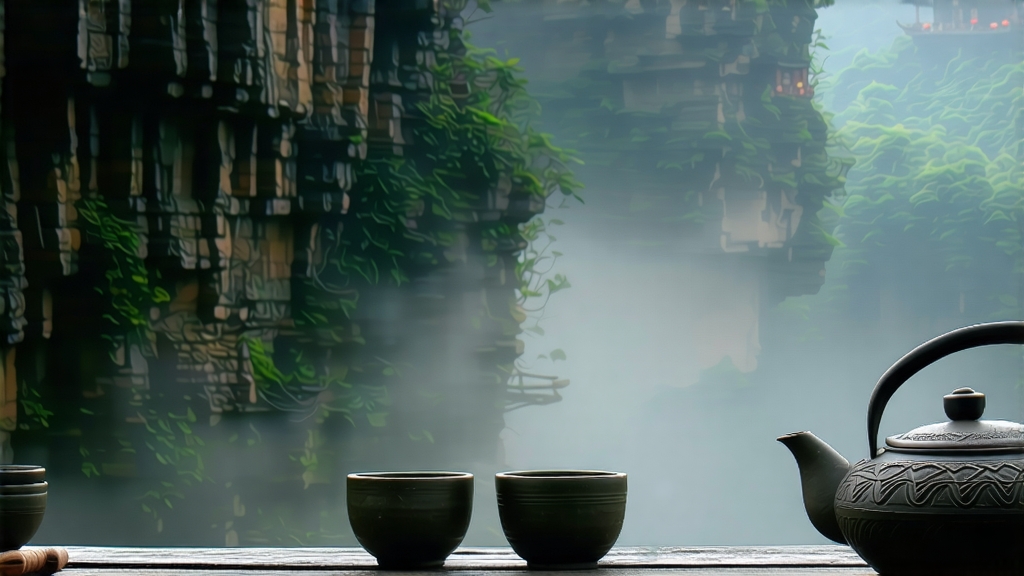
High in the mist-curtained Wuyi Mountains of northern Fujian, vertical cliffs of purple sandstone rise above the Nine-Bend River like petrified waves. In the crevices of these almost barren rocks, gnarled tea bushes have clung for centuries, their roots drilling into mineral-rich fissures in search of water. The leaves they yield are the raw material for Da Hong Pao—literally “Big Red Robe”—the most mythologized of China’s five hundred-odd oolong styles. To understand why a single 350-gram packet of authentic mother-tree Da Hong Pao once sold for over forty thousand U.S. dollars, one must step back four centuries and listen to the monks, merchants, and emperors who draped this tea in legend, then forward to the charcoal masters who still bend over bamboo baskets at 3 a.m., coaxing the leaf through a twelve-hour roast that tastes of volcanic stone and dried longan.
Legend first. In the late Ming dynasty, a scholar on his way to the imperial exams in Beijing fell gravely ill at the foot of Wuyi’s Tianxin Rock. Monks from the nearby Yongle Temple brewed a strong infusion from the bushes that grew just outside the temple gate; the scholar revived, continued north, and placed first in the exams. To express gratitude, he returned in the crimson silk robe awarded by the emperor, draped it over the four mother bushes, and kowtowed nine times. The robe remained until wind and rain reduced it to threads, but the name stuck: Da Hong Pao. Qing-era tax records list “Red Robe tribute tea” among gifts sent to the Forbidden City, and Republican-era photographs show uniformed soldiers standing guard over the same four bushes during the 1930s, already considered national treasures.
Botanically, those mother bushes—now protected and no longer harvested—belong to the Qi Dan cultivar, a naturally occurring hybrid of local Wuyi wild tea and the Minnan Tieguanyin brought north by itinerant monks. Yet “Da Hong Pao” today is less a single cultivar than a stylistic summit toward which dozens of Wuyi bushes aspire. Producers blend leaves from six approved rock-variety cultivars—Qi Dan, Bei Dou, Que She, Tieluohan, Baijiguan, and Shui Jin Gui—to recreate the fragrance, throat texture, and lingering mineral sweetness known collectively as yanyun, “rock rhyme.” The Chinese describe yanyun as the taste you get when you lick a wet Wuyi cliff: a cool, stony note that arrives after swallowing and lingers between molars like struck flint. No other oolong pursues this sensation so single-mindedly.
Harvest begins in late April, when morning mist still softens the sun and the leaf’s moisture content hovers around 75 percent. Two leaves and a bud are plucked by bamboo-nailed baskets strapped to the backs of climbers who scale nearly vertical faces using iron foot pegs hammered into the rock. Once carried down to the valley, the leaves are spread on bamboo trays to wither under natural shade for two hours, then tossed in massive rattan drums every forty minutes for the next eight. This bruising ruptures cell walls, allowing enzymes to meet oxygen and initiating the partial oxidation that places oolong between green and black tea. When the leaf edges turn chestnut and the centers remain jade, oxidation is halted by a five-minute blast at 220 °C in gas-heated woks. The kill-green step is brief; prolonged heat would flatten the mineral notes that took centuries to absorb from the cliff.
What follows is the signature Wuyi roast, a two-stage marathon that can last sixteen hours and defines the tea’s final personality. First, the leaf is spread two centimeters deep on hemp cloth stretched over charcoal pits fired by local hardwood. Masters—almost always men over fifty whose forearms are mapped with old burn scars—shuffle the cloth every three minutes so that no leaf touches the embers for more than ten seconds. Temperature is judged by the color of the ash: silvery white means 90 °C, perfect for the initial “water extraction” that reduces residual moisture to 8 percent. After a four-hour rest, the leaf returns to the pit for the “foot fire,” a slower roast at 70 °C that caramelizes sugars and coaxes out dried-fruit aromatics. The entire cycle is repeated up to three times over the following month, depending on how the